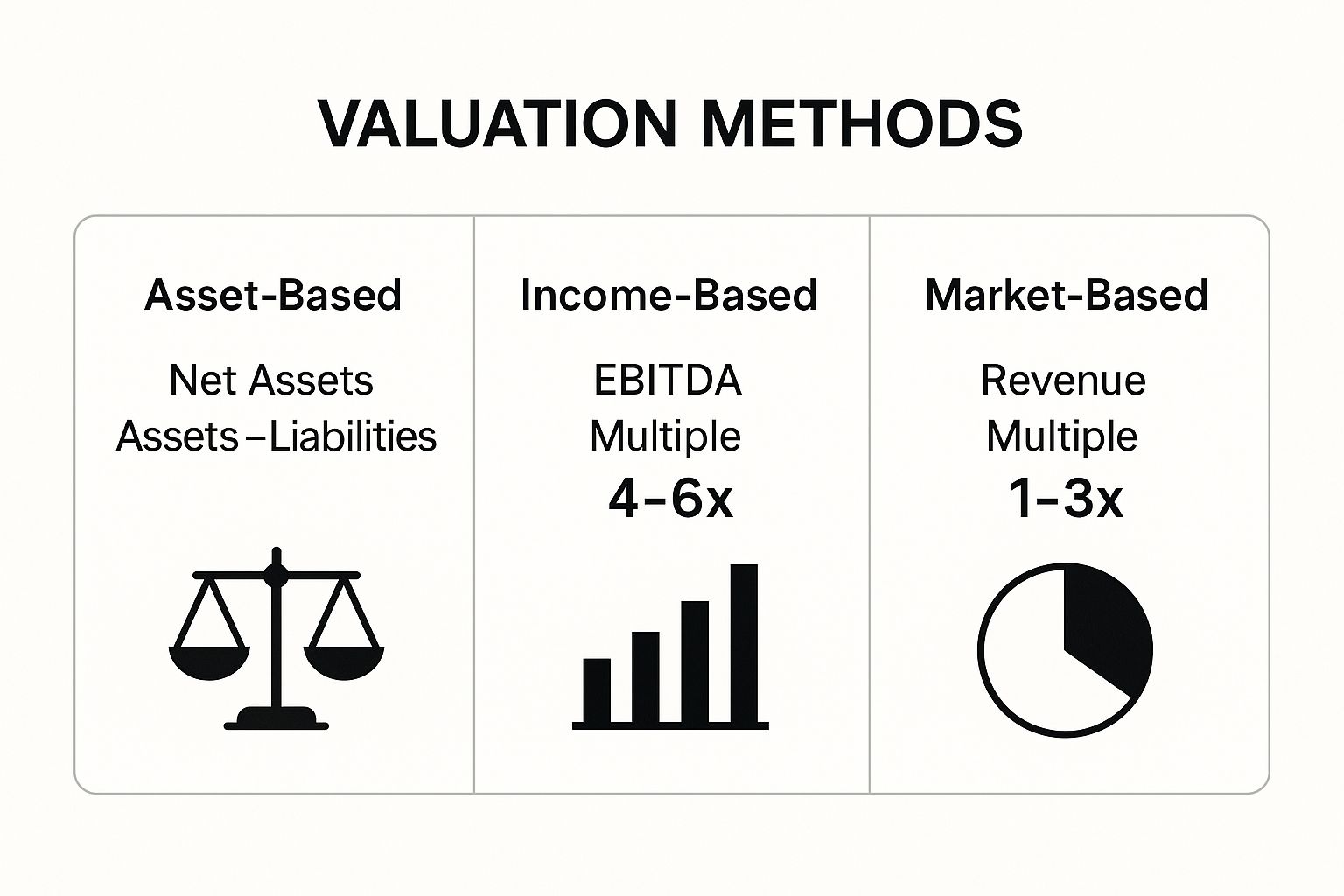Stay Updated with Everything about MDS
Thank you! Your submission has been received!
Oops! Something went wrong while submitting the form.

Chilat Doina
August 13, 2025
Lots of founders get so wrapped up in building their business that they completely forget to plan how they'll one day leave it. I've seen it happen time and time again. This isn't just a minor oversight; it's a huge—and often costly—mistake.
Thinking ahead about your business exit strategy is one of the most important parts of being a responsible owner. It’s what secures the legacy you’ve poured your life into and ensures you walk away with the maximum possible payout.

I get it. Thinking about your exit feels completely backward when you're still pushing for growth. But delaying this conversation is one of the biggest financial risks any entrepreneur can take.
An exit strategy isn't a white flag of surrender. It's a roadmap for smart growth. It's the critical tool that shapes the future of both your company and your personal wealth.
When you don't have a plan, you’re basically gambling with your company's fate and your own financial future. An unexpected life event, a sudden market downturn, or a surprise buyout offer can force your hand, and you'll be stuck in a weak negotiating position.
Waiting until you're burned out or just ready to hang it up is far too late. The most successful exits I've witnessed were the result of years of deliberate, careful preparation. Pushing your exit strategy to the back burner exposes you to some very real dangers:
For most business owners, the exit is directly linked to their personal financial picture. That’s why it’s so important to connect with professional retirement planning services early on. They can help make sure your business exit aligns perfectly with the life you want to live long-term.
The numbers don't lie. The data overwhelmingly shows that owners who plan their exit see much, much higher financial returns. It’s not even close.
A study looking at the difference planning makes showed some eye-opening results.
| How Exit Planning Impacts Business Profitability || :--- | :--- | :--- || Owner's Intention | Median Profit | Key Takeaway || Plan to Sell or Transfer | $100,000 | Proactive planning directly correlates with higher financial outcomes. || Intend to Shut Down | $20,000 | A lack of planning leaves significant money on the table. |
The gap is massive. Owners who actively plan for a sale or transfer walk away with significantly more than those who just decide to close up shop. This really highlights the financial power of strategic preparation.
The data also points to a sweet spot for timing: starting your preparations 18 months to three years before you plan to exit is crucial. This window gives you enough runway to get your business aligned with what buyers are looking for and to ride favorable market trends.
Interestingly, about 70% of owners would rather see an internal transfer, with over half dreaming of passing the business to family. This makes early succession and structural planning an absolute must.
At the end of the day, a well-thought-out exit strategy is the best insurance policy for the value you’ve spent your life creating.
Figuring out how to leave the business you poured your heart and soul into is a massive decision. It's not some abstract thought exercise; it’s one of the most personal and financially significant choices you'll ever make as an entrepreneur.
What works for a high-flying tech startup is completely different from what’s right for a stable, family-run manufacturing business. The real trick is to align the exit strategy with your personal goals, your company's current reality, and how involved you want to be down the road.
Each path comes with its own unique set of trade-offs—in terms of money, time, and the legacy you leave behind.
When most people think of a business exit, they picture selling to another company. This is your classic M&A deal, usually with a strategic buyer in your industry. This is the perfect route if you’ve built something a larger company desperately wants—be it unique tech, a killer brand, a fiercely loyal customer base, or a foothold in a new market.
A strategic buyer isn't just buying your current profits; they’re buying a competitive edge. That's why they'll often pay a premium. Think about a big software corporation acquiring a small firm with a popular niche feature. They can integrate that feature, swallow a competitor, and absorb their customers all in one move.
Selling your business is a marathon, not a sprint. The M&A process is intense and can easily take 9-18 months. Be prepared for some serious digging during due diligence, but the potential for a fat valuation makes it a very appealing option for the right companies.
What if the perfect person to take over your business is already on your payroll? A Management Buyout (MBO) is when you sell the company to your existing leadership team. This is a fantastic way to keep things running smoothly and preserve the culture you worked so hard to build. You get to leave your legacy in the hands of people who already get it.
Another route is an Employee Stock Ownership Plan (ESOP), where you essentially sell the business to all your employees. It’s a powerful way to thank the team that helped you get where you are, and it comes with some nice tax benefits. Both MBOs and ESOPs are best for stable, profitable companies with predictable cash flow, since the buyers will likely need to finance the purchase.
The image below breaks down some of the common valuation frameworks that are absolutely crucial in these discussions, whether the buyer is internal or external.

This gives you a glimpse into how different buyers will crunch the numbers to figure out what your business is worth.
While M&A and MBOs get a lot of attention, they’re not the only games in town. A smart exit plan considers every possible door.
A Practical Comparison of Business Exit Strategies
I've seen founders go down many different paths. To help you get a clearer picture, here’s a quick rundown of the most common options, who they're best for, and what you can realistically expect.
Choosing the right strategy means being honest about your company's potential and your personal priorities. Let's dig into a few of these in more detail.
Initial Public Offering (IPO): This is the dream for many, but it's an absolute beast. Going public is for rocket ships with massive potential. It can generate incredible wealth, but it's also wildly expensive, complicated, and wraps you in layers of regulations.
Family Succession: Passing the torch to your kids is a powerful legacy move. It requires years of careful planning, grooming the next generation of leaders, and having some very honest conversations to keep family drama from derailing the business.
Private Equity Sale: Selling to a PE firm can mean a big payday. These guys look for solid businesses they can tune up and flip in 5-7 years. Just be ready for an intense focus on growth and a potential loss of day-to-day control. For my fellow e-commerce folks, a popular twist on this is to sell your FBA business to one of the many aggregators out there.
Strategic Liquidation: This sounds harsh, but sometimes shutting down and selling off the parts is the smartest financial move. It's often a last resort, but it can be the right call if the business is struggling or the assets (like real estate or intellectual property) are worth more than the company itself.

A successful exit all comes down to one thing: a realistic and defensible valuation. If you get this number wrong, it can torpedo your entire plan, leaving you with a lowball offer or, even worse, no deal at all. The goal isn't to pull a number out of thin air; it's about figuring out what your company is truly worth in the current market.
The first step in any solid business exit strategy planning is learning to see your company through a buyer's eyes. This perspective shift helps you spot weaknesses and strategically build value long before you’re even thinking about listing.
Valuation isn't black magic. It's really a blend of art and science. Most buyers, and the advisors they bring in, will rely on a mix of three main methods to figure out what your business is worth. Each one tells a slightly different part of your company's financial story.
Asset-Based Valuation: This is the most straightforward way to look at things. You just add up your total assets (cash, gear, inventory, property) and subtract your total liabilities (debt, what you owe suppliers). It’s simple, but it usually misses the stuff that makes a business really valuable, like your brand reputation or customer loyalty.
Income-Based Valuation: This method is all about your company’s power to generate cash. The go-to approach here is the Discounted Cash Flow (DCF) analysis. It projects your future cash flow and then brings it back to today's value. Another popular metric is a multiple of EBITDA (Earnings Before Interest, Taxes, Depreciation, and Amortization), which is a quick-and-dirty way to size up profitability.
Market-Based Valuation: This is your reality check. It looks at what similar companies in your space have sold for recently. For example, if comparable SaaS businesses are fetching a 5x multiple of their annual recurring revenue (ARR), that gives you a pretty solid benchmark for your own valuation.
A huge mistake I see owners make is hanging their hat on just one method. Smart owners triangulate all three. Your asset value is your floor, your income shows your earning potential, and market comps prove what people are actually paying right now.
A buyer isn't just buying your history; they're buying your future. The numbers on a spreadsheet are just the beginning of the story. Experienced acquirers always dig deeper, looking at the qualitative factors that can make or break a deal—or at least dramatically change the offer.
These are the value drivers you should be obsessed with improving, starting years before your exit.
Ultimately, valuing your business means you have to understand both the hard numbers and the softer, strategic assets. While these principles apply across the board, the specifics can vary by industry. To get a better handle on this, it's worth exploring various stock valuation methods to see how financial pros assess value from different angles.
Whatever you do, don't overlook the incredible value of your brand. A strong brand can be one of your most powerful assets, even if it's the hardest to slap a number on. It's all about trust, customer loyalty, and your position in the market—all things that can lead to a higher sales multiple.
For those of us in the e-commerce world, knowing how to value a brand isn't just a thought exercise; it's a critical piece of maximizing what you walk away with. A respected and recognized brand name can be the single thing that makes a buyer choose you over a competitor with nearly identical financials.

Thinking you can go it alone when selling your business is one of the most common—and most expensive—mistakes an entrepreneur can make. This isn't just another project. An exit is a high-stakes, multi-front war of negotiation, legal maneuvering, and intense financial scrutiny.
Trying to lead that charge while also running your company day-to-day is a classic recipe for burnout and, frankly, a bad deal.
This is where your deal team comes in. Think of this hand-picked group of specialists as your personal board of directors for the entire exit process. Their sole job is to protect your interests, squeeze every last drop of value out of your valuation, and keep the deal on track. This frees you up to focus on what’s most critical during this period: maintaining business performance.
Don't even think about skimping here. The quality of your advisors will have a direct, dollar-for-dollar impact on the final number on that check. A great team pays for itself many times over. A weak one can cost you millions in missed opportunities or unforeseen problems.
It's not just about hiring professionals; it's about assembling the right professionals who can work together as a cohesive unit.
Your core team absolutely needs to include:
The synergy between these players is everything. When they collaborate effectively, no detail gets missed. For more on this, our guide on building high-performing teams has some great insights that are just as relevant for your advisory squad as for your internal staff.
Once you have a serious buyer, get ready for due diligence. This is an exhaustive, deep-dive investigation into every single corner of your company. It’s intense, and it can feel incredibly invasive. Being unprepared is a massive red flag for buyers—it signals disorganization and can kill deal momentum in a heartbeat.
Proactive preparation for due diligence is one of the strongest signals of a well-managed company. It builds trust with the buyer, streamlines the process, and helps you command a higher valuation by avoiding last-minute surprises.
Start putting together your virtual data room now. This is simply a secure online folder where you'll house all the documents the buyer and their team will want to review. Think of it as a pre-packaged, comprehensive history of your business, ready for inspection.
Getting your documents in order long before a buyer is even at the table can shave weeks, or even months, off the deal timeline. More importantly, it gives you a chance to spot and fix any potential issues on your own terms.
Here’s a practical breakdown of what you need to start gathering:
Financial Documents: This is where the most intense scrutiny will be.
Legal & Corporate Records:
Operational Information:
Having this information organized and ready to go demonstrates a level of professionalism and control that gives buyers the confidence they need to move forward and pay top dollar.
Timing is everything when you sell a business. I’ve seen it happen time and time again. A fantastic company goes to market during a downturn and gets a disappointing price. On the flip side, I’ve watched a solid, but otherwise unremarkable, business fetch an unbelievable valuation just because they sold when their market was white-hot.
Getting your own house in order is only half the battle. You absolutely have to understand the external forces at play. Aligning your exit with favorable market conditions can be the difference between a good outcome and a life-changing one. It all comes down to developing a keen awareness of both the big-picture economy and the specific microclimate of your industry.
The overall health of the economy sets the stage for every single deal. Think of key macroeconomic indicators as signals telling you whether it’s a seller’s market or a buyer’s market. Heading into a sale without checking them is like setting sail without checking the weather forecast.
You really need to keep a close eye on a few major factors:
Beyond the broad economy, your specific industry has its own weather patterns. A sector that’s on fire can defy a sluggish economy, while a struggling industry might not get any lift from a national boom.
A few years back, for instance, e-commerce aggregator brands were buying up businesses at a frantic pace, driving valuations to insane heights. That was a crystal-clear window of opportunity. Today? That market has cooled off considerably.
The real trick is to identify when your industry is in favor with investors. Is a new technology causing a wave of M&A activity? Is a regulatory change forcing the market to consolidate? Seeing these micro-trends allows you to ride the wave instead of getting crushed by it.
A perfect example of how quickly things can change happened in the private equity world. In early 2025, PE exit activity dropped to a two-year low. Firms only closed 473 exits globally for about $80.81 billion in that first quarter. This massive drop was mostly driven by market uncertainty from new tariff policies, which created a huge gap between what sellers thought their companies were worth and what buyers were actually willing to pay. You can get more details on how market volatility impacts exit strategies from S&P Global.
This just goes to show how fast global economic shifts can change the entire game, forcing even the most seasoned investors to pivot.
Here’s the thing: you can't control the market. But you can absolutely control your own preparedness.
Market windows open and close, sometimes unexpectedly. The best strategy is to get your business "sale ready" before you need to be. This means your financials are clean, your deal team is on standby, and your key documents are prepped for due diligence.
This state of readiness gives you the ultimate advantage: flexibility.
When that perfect market window suddenly appears, you can move fast and decisively. If a surprise downturn hits, you have the operational and financial strength to simply wait it out, avoiding a desperate fire sale. Real business exit strategy planning isn't about predicting the future; it's about preparing for the certainty of uncertainty.
Even with a great framework, the road to an exit is full of personal, high-stakes questions. It’s a path most of us only walk once, so it’s completely normal to have concerns. Let’s dig into some of the most common questions I hear from fellow entrepreneurs as they think about business exit strategy planning.
Getting straight answers to these questions now can save you from massive headaches and very expensive mistakes later on.
Look, the ideal answer is three to five years before you actually plan to sell. I know that sounds like a long time, but some of the sharpest founders I know started their business with an exit in mind from day one.
Giving yourself that long of a runway is a huge strategic advantage. It gives you the time to methodically increase your company's value, get your financials absolutely pristine, fix any operational weaknesses, and—this is the big one—build a leadership team that can run the business without you.
Starting early also buys you the one thing you can't put a price on: flexibility. You get to wait for the right market conditions instead of being cornered into a sale because of a sudden life event or a souring economy. I’ve seen it happen time and again: rushing the process almost always means leaving money on the table.
The best exits are never a surprise. They are the deliberate result of years of preparation. Don't think of it as planning to leave; think of it as building a business that is ready to be sold at any time for maximum value.
I’ve seen this mistake torpedo more deals than anything else: building a business that is completely dependent on the owner.
If every key client relationship, piece of specialized knowledge, and critical operational decision lives only in your head, a buyer sees one thing: massive risk. From their perspective, the company’s most valuable asset is walking out the door the day the deal closes. This "key-person risk" is a notorious valuation killer.
To sidestep this trap, you have to systematically make yourself redundant. It feels wrong, I know, but it’s the single most important move you can make to maximize your final price.
A business that can thrive without its founder isn't just sellable—it's a premium asset that will command a much higher multiple.
Confidentiality isn't just important; it's everything. A premature leak can unleash total chaos. Your best employees might get spooked and start looking for the exits. Competitors could use the news to their advantage. And key customers or suppliers might get nervous and start pulling back.
To keep things under wraps, you have to operate within a tiny, trusted circle. This usually means just your core advisory team—your M&A advisor, attorney, and CPA—all of whom should be locked down with ironclad non-disclosure agreements (NDAs).
When it's time to actually approach buyers, your M&A advisor will run a "blind" process. They'll send out a high-level, anonymous profile of your business to potential suitors. Your company’s name is only revealed after a buyer has been vetted and signs a comprehensive NDA of their own.
You should only bring your key managers into the fold when it's absolutely necessary for due diligence. This is often handled by offering retention bonuses or other financial incentives tied to the successful close of the deal, which ensures you have their full cooperation and discretion.
This is exactly why solid business exit strategy planning isn't about having one plan—it's about having multiple scenarios. Your "Plan A" might be a strategic sale to a huge competitor for a top-dollar multiple, but you absolutely must have a Plan B and even a Plan C ready to go.
Things happen. Markets turn, buyers get cold feet, and life throws curveballs.
For instance, if the M&A market suddenly freezes up, have you considered if a management buyout (MBO) with your leadership team is a viable option? If a sale is off the table for now, is the business profitable enough for you to step into a passive ownership role and live well off the distributions? A well-prepared owner has already thought through these different paths and understands the financial and personal impact of each one.
This layered strategy makes you resilient. It means you always have an alternative, allowing you to pivot intelligently if your main path gets blocked and protecting the legacy and wealth you've worked so hard to build.
At Million Dollar Sellers, we know that building to an exit is the ultimate goal for many high-achievers. Our private community is where 7-, 8-, and 9-figure e-commerce founders share the exact strategies they're using to scale, optimize, and prepare their brands for a maximum-value exit. Learn more and see if you qualify to join the conversation at Million Dollar Sellers.
Join the Ecom Entrepreneur Community for Vetted 7-9 Figure Ecommerce Founders
Learn MoreYou may also like:
Learn more about our special events!
Check Events